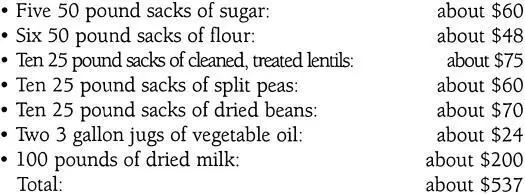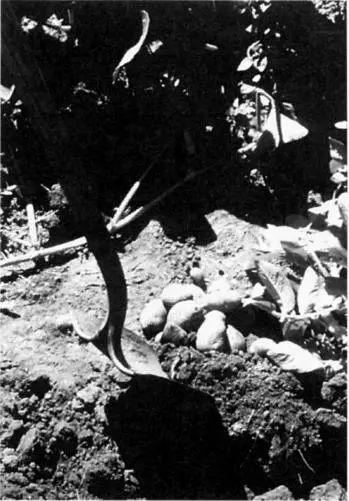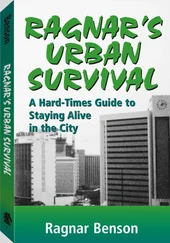Ragnar Benson - Ragnar's Urban Survival - A Hard-Times Guide to Staying Alive in the City
Здесь есть возможность читать онлайн «Ragnar Benson - Ragnar's Urban Survival - A Hard-Times Guide to Staying Alive in the City» весь текст электронной книги совершенно бесплатно (целиком полную версию без сокращений). В некоторых случаях можно слушать аудио, скачать через торрент в формате fb2 и присутствует краткое содержание. Год выпуска: 2009, ISBN: 2009, Жанр: Старинная литература, на английском языке. Описание произведения, (предисловие) а так же отзывы посетителей доступны на портале библиотеки ЛибКат.
- Название:Ragnar's Urban Survival: A Hard-Times Guide to Staying Alive in the City
- Автор:
- Жанр:
- Год:2009
- ISBN:1581600593
- Рейтинг книги:5 / 5. Голосов: 1
-
Избранное:Добавить в избранное
- Отзывы:
-
Ваша оценка:
- 100
- 1
- 2
- 3
- 4
- 5
Ragnar's Urban Survival: A Hard-Times Guide to Staying Alive in the City: краткое содержание, описание и аннотация
Предлагаем к чтению аннотацию, описание, краткое содержание или предисловие (зависит от того, что написал сам автор книги «Ragnar's Urban Survival: A Hard-Times Guide to Staying Alive in the City»). Если вы не нашли необходимую информацию о книге — напишите в комментариях, мы постараемся отыскать её.
Ragnar's Urban Survival: A Hard-Times Guide to Staying Alive in the City — читать онлайн бесплатно полную книгу (весь текст) целиком
Ниже представлен текст книги, разбитый по страницам. Система сохранения места последней прочитанной страницы, позволяет с удобством читать онлайн бесплатно книгу «Ragnar's Urban Survival: A Hard-Times Guide to Staying Alive in the City», без необходимости каждый раз заново искать на чём Вы остановились. Поставьте закладку, и сможете в любой момент перейти на страницу, на которой закончили чтение.
Интервал:
Закладка:
Whole grains such as whole wheat, barley and untreated dried peas are too basic, in my opinion. Wheat and barley as they come from the farm, are very inexpensive and easy to acquire. But, if they come directly from the farm they will also contain dirt, trash, chaff, rodent droppings, and bugs that are not particularly nice to deal with in our food. Also, this stuff is the devil to store over the long term.
Avoid all of the instruction regarding dry ice, freezing, and whatnot by purchasing commodities that have been factory cleaned, sterilized, and packaged. To that end I really like dried split peas, dried milk, lentils, dried beans, milled wheat flour, basic sugar, and vegetable oil as stored survival rations.
Dried split peas, lentils, and dried beans are, to some extent, an acquired taste. Especially if that's all there is with little variety day to day. But add a bit of rabbit, pigeon, cattail, fish, duck, or rat from time to time and these foods start tasting good. They are also extremely nutritious.
All these dried goods are simple and cheap to purchase as well as easy to store. Absolutely every large warehouse supermarket I have been in has all of these items in large, durable, sealed bags.
My basic supply for a family of four for 1 year, assuming some augmentation from fields and garden, is as follows:

Try buying this level of eating using MREs for anywhere near this money.
Reconstituted with water and bulked with a few other items brought into the retreat, the above stocks will definitely sustain life for a party of four for 1 year. Simplicity always counts heavily in survival situations, and this inventory is simplicity itself. The entire year's supply will fit under a folding table!
As long as the bags ae kept from dampness, rats and mice, bugs, and physical damage, all this supply can be stacked as is on shelves. I presently keep two-thirds of my supply piled on an open shelf in a special, mouse-proofed storeroom.
Most city survivors take the additional precaution of further sealing their emergency rations in large plastic garbage cans. Although rotating supplies is advised, I have peas and lentils sealed in these cans from 1976! All are in reasonably good condition, with little to no stale taste when cooked up.
Barter of excess or unneeded food supplies is mentioned by all of the been there, done that crew. Because this list of emergency foods is so modest and currently so cheap and easy, survivors may wish to double or triple listed amounts. Storage and caching involves more than this humble list of food, and will be covered in depth in Chapter 9.
A MATTER OF TASTE
Many of these food items are very much an acquired taste. It is likely you won't like lentils. Most Americans do not. Experimenting a bit now could make the process easier later. In their defense, lentils are considered to :)e one of the best, most nutritious highdensity sources of vegetable protein!
This chapter is about sustaining life on a number of unusual to weird to frequently repulsive food items. Not a lot of familiar meat and potato items are found here. My mind goes back to the Indians (on the Indian subcontinent) as contrasted with the Chinese whenever I contemplate food issues and survival. Both countries have roughly similar land areas, population densities, growing seasons, soil, rainfall, and general crop-raising capacities.
Yet there are dramatic differences in their societies. At the same time that the Indians go hungry, sometimes starving as a result of periodic famine, the Chinese grow fat. The question is, "Why?" It's simplicity itself. My personal, on-the-ground observation is that the Chinese eat everything from shark fins to bird nests, to duck feet and tongues, convincing themselves in the process that they are eating delicacies.
Indians, on the other hand, are beset and constrained by dozens and dozens of cultural, religious, social, and structural taboos that preclude them from enjoying and eating things all around them. Indians of some sort or another won't eat pork, cattle, chickens, snakes, some seafood, some mammals, and a host of stuff in between. An average Indian hotel restaurant usually has five different menus, virtually from five different kitchens requiring five different sets of pots and pans. How they traditionally sorted it out without using computers is a mystery. The problems with confusion and inefficiencies in this system are obvious.
Survivors, in the city or anyplace else, don't have time for such fooling around. You will have to eat what is on hand, receiving with thanks whatever will sustain life.
Chapter 7

Survival Food Preservation
Quick, why do commercial potato farmers often leave the equivalent of fifty 100-pound bags of potatoes per acre lying in the field to waste? Fully understanding this concept is central to understanding the means and necessity of survival food preservation.
No matter if it is a tiny city survivors garden plot or a 40,000- acre Iowa corn farm, edible food matures and comes rushing in over a very short time span. Harvest doesn't happen all at once, but almost. Potato farmers, worried about 450-bags-to-the-acre yields, won't give a rip for tiny potatoes-worth, at most, a penny a pound-that fall through the sorting chain.
It's all a Golden Rule of Food Production, of which most long-term city residents are completely unaware: Provisions must be made, both in the survivor's thinking and his emergency supplies, to handle rush harvests. Nine times out of 10, harvests happen quickly, often under great duress. Think of it as suddenly being given a 1,200 pound steer that is only yours if you can process it. Also saying that temperatures are in the 90s adds realism to the example.
What are you going to do with the critter? Eat one or two steaks or a pound of burger? That would be nice, but it doesn't work that way. To eat one steak you either have to eat it all or fig ure some way to preserve the remainder. Russian quartermasters, for example, delivered live cattle to the soldiers on the Eastern Front during World War I as their daily food ration. Russian quartermasters didn't fuss with MREs. One cow reportedly was issued for every 600 soldiers. Soldiers butchered the critters right there on the front line and ate it all immediately.

New potatoes dug, dried, and ready for storage.
One way, but probably not always the best way, of storing food is delaying butchering till the time of need or, in the case of vegetable gardens, delaying harvesting. Indeed, live fish can be left in the fish trap; turtles, as mentioned, can be wired up in deep holes in the river; pigeons can be left on the roost; and rabbits, to some limited extent, can be left in their hutch. Back on the farm we frequently butchered chickens when company came over unexpectedly. But that was chickens.
Problem is, fish and turtles might contrive to escape; rabbits and pigeons grow older and tougher, eating lots of precious food in the process; and, of course, garden vegetables can easily rot on the vine or in the ground if they are not dealt with promptly. Theft is a serious problem in any high-energy survival situation. Leave too much largesse on display and others may recognize and appropriate it.
Adding shelf life to food is an ancient problem. Most techniques we currently have available came over on the Mayflower. The only exception is freezing and perhaps freeze-drying. Freezing is a viable survival technique in some circumstances, but generally we still rely on salting, drying, and canning or some combination of the above. Preservation by canning really only came on the scene about 1795 during the time of Napoleon, who encouraged this new technology as a means of feeding his armies! Making jerky out of surplus meat is the oldest and perhaps least exotic food preservation technique. In a complete survival circumstance, it is often the only way of preserving our hypothetical 1,200-pound steer.
Читать дальшеИнтервал:
Закладка:
Похожие книги на «Ragnar's Urban Survival: A Hard-Times Guide to Staying Alive in the City»
Представляем Вашему вниманию похожие книги на «Ragnar's Urban Survival: A Hard-Times Guide to Staying Alive in the City» списком для выбора. Мы отобрали схожую по названию и смыслу литературу в надежде предоставить читателям больше вариантов отыскать новые, интересные, ещё непрочитанные произведения.
Обсуждение, отзывы о книге «Ragnar's Urban Survival: A Hard-Times Guide to Staying Alive in the City» и просто собственные мнения читателей. Оставьте ваши комментарии, напишите, что Вы думаете о произведении, его смысле или главных героях. Укажите что конкретно понравилось, а что нет, и почему Вы так считаете.











